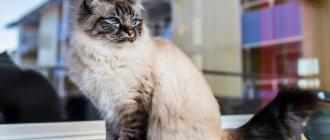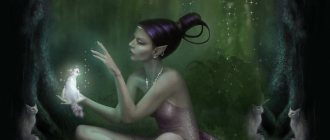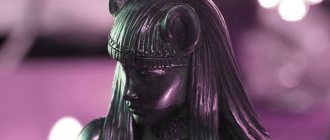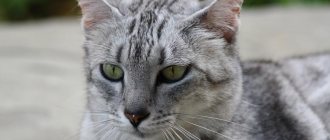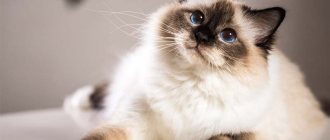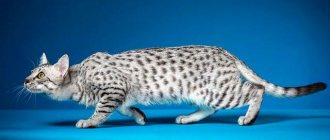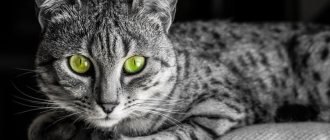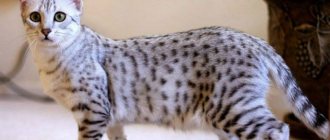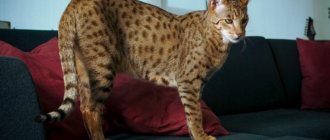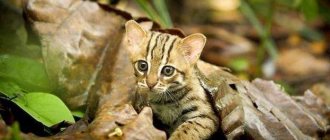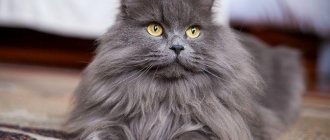History of the Egyptian Mau breed
Egyptian Mau
The origin of the beauties goes back to the 6th-5th millennium BC. e. - the harsh era of the pharaohs, servile worship of the gods, trade in “living goods” and amazing unsanitary conditions. Egypt managed to become a rich and majestic country, despite the proximity of the desert and regular floods of the Nile River. The ruling dynasties bathed in luxury and honor. Commoners were forced to live with unfriendly fauna - rats, poisonous snakes and insects - which made an already difficult life even more burdensome.
Fortunately for the Egyptians, not all animals were hostile. African cats - the future ancestors of the Mau - often came to modest settlements, destroyed parasites and just as silently left. Over time, the unexpected alliance grew stronger. In gratitude for their help, the Egyptians rewarded cats with treats from their own food supplies and immortalized their noble appearance in art. Animals were allowed to enter the house, and soon they completely got used to the role of owners. This marked the beginning of the full domestication of African cats, which were used in hunting.
The first image of a domesticated cat found in a temple dates back to the 2nd millennium BC. e. At that time, animals played almost a central role in religion. The Egyptians believed that the main deity - the sun god Ra - turns into a cat, rising into the sky in the morning and descending underground in the evening, where Apophis, the god of chaos, awaits him every day, eager to engage in battle with his rival. Ancient drawings often depicted Ra in the guise of a huge spotted cat, tearing apart the enemy with sharp claws.
The connection between the four-legged beauties and the supreme god of the pantheon was also seen in their eyes. It was believed that the pupils of cats determine the position of the sun above the horizon: the wider they are, the lower the celestial body. In fact, changes in the size of the pupils are associated with their physiological characteristics, but in ancient times the incomprehensible nature of things was always explained by the intervention of higher powers.
From about the 1st millennium BC. e. cats were included in the cult of Bastet - the goddess of beauty, fertility and hearth. She was depicted as a woman with the head of a cat, sometimes in full animal form. Temple servants increasingly began to keep four-legged companions with them - the living embodiment of Bastet. Cats walked freely throughout the entire territory of the sanctuary, which was inaccessible to commoners. Forbidding animals to do anything was considered almost a mortal sin: they knew how to speak with the gods and protected those praying from dark forces. Amulets with their image brought the owner good luck in love.
Egyptian Mau bronze color
The sanctuary of Bastet - Bubastion - was visited by the Egyptians more often than others. Every day, believers handed over mummified cats to the priests, which were buried in separate rooms along with rodents and a vessel filled with milk. According to mythology, animals went to the afterlife, where they met Bastet and conveyed the requests of pilgrims to her.
An amazing legend is also associated with the ancestors of the Egyptian Mau, which emphasizes the importance of cats. Thus, the Persian king Cambyses from the Achaemenid dynasty won an easy victory over the Egyptians in 525 BC. e. thanks to these animals. On his orders, the soldiers caught the cats and tied them to their shields. The fear of the sacred companions of Bastet became the decisive factor: the townspeople laid down their arms because they did not want to harm the cats.
Despite their ancient origins, the history of the more modern descendants of the Egyptian Mau began in the 20th century, when European cat breeders decided to revive and breed a unique breed. The first mentions of that time date back to 1940, namely the publication in France of the memoirs “Our Cat Friends.” In them, Marcel Rene talked about spotted animals that he brought from Egypt. Unfortunately, the events of World War II significantly reduced the Mau population. The breed was on the verge of extinction and by the middle of the 20th century practically ceased to exist.
The repeated revival of the “Egyptian women” turned out to be successful, largely thanks to the activities of Natalia Trubetskoy. The Russian princess emigrated to Italy during the war, where in 1953 she first became acquainted with the magnificent spotted animals. They were presented as a gift by a Cairo man. Thus, Trubetskoy became the owner of Gregorio and Geppa of black and smoky colors, respectively, as well as the silver cat Lilu. In the same year, the first babies were born, which the princess immediately announced to representatives of the Italian branch of the International Cat Organization (FIFe).
In 1955, luxurious beauties appeared at a Roman exhibition, where they created a sensation. Three years later, Trubetskoy swapped sultry Italy for the unknown romance of the USA and took in several Mau - silver cats Baba and Lisa, as well as a bronze baby named Jojo. This is how the first Mau nursery, Fatima, appeared in America, where, under the leadership of Princess Trubetskoy, a team of breeders began breeding Egyptian beauties. At the same time, they decided to allow cats of smoky, bronze and silver colors to participate in exhibitions. Animals with black fur were kept exclusively for breeding. Natalia Trubetskaya was engaged in the selection of kittens that were as similar as possible to the ancient Egyptian cats from the frescoes.
All the wards of the Fatima nursery were conditionally united into the traditional Mau line. Subsequently, the breed was divided into two more branches - Indian and Egyptian. Cats brought from the respective countries participated in their creation. The appearance of individual Mau suggested that American Shorthair cats were also involved in the selection.
Official recognition of the breed by felinological organizations began in 1968, when representatives of the CFF approved the Mau standard. Other organizations also caught the Egyptian “fever”: CFA (1977), TICA (1988), FIFe (1992). The new breed from the Land of the Pharaohs was also recognized by the lesser-known ASC, ICU, and WCF. Stud book records of ancestry and pedigree were used to register each cat.
The Egyptian Mau returned to Europe in 1988. At the same time, on the initiative of Mau lovers, three official nurseries were created. Now representatives of the breed are found in Belgium, Italy, Great Britain, the Netherlands, Germany, France and Switzerland, although the number of breeders is still negligible. The lion's share of nurseries comes from America, which does not want to share its achievements in breeding Egyptian Mau. To acquire a smaller copy of an African predator is a rare success.
History of the origin of the breed
The Egyptian Mau is rightfully considered a descendant of the sacred cats of the ancient Egyptians, Nubian cats.
According to legend, Nubian cats are descended from African wild cats that lived alongside humans at the time. They were the ones who protected the ancient Egyptians' households from mice and snakes; as a result, their owners began to encourage them and settle them in their homes. Mau is the common ancient Egyptian name for cats, which they received due to their loud pronunciation of the word “Ma-a-a-u”.
The modern history of the Egyptian Mau began 100 years ago, when Italian, French and Swiss cat breeders decided to recreate the ancient breed and brought the spotted shorthair cat from Egypt. Unfortunately, the Second World War had a bad impact on the noble initiatives of the breeders and destroyed almost the entire livestock.
It was very lucky that after the war, the Russian princess Natalie Trubetskoy lived in Italy, who was on good terms with the ambassador of Syria. One day, while paying a visit, she saw this breed of cats on his estate and was simply fascinated by their beauty. It was the Syrian ambassador who helped the princess acquire the Egyptian Mau directly from Cairo. They were: a black cat named Gregorio, a smoky cat named Gappa and a silver cat Lilu. Later, when the princess moved with her pets to America, she did everything to register her Fatima cattery and 10 Egyptian Mau cats. Later, several breeders in the USA took up the breed. Americans, to this day, are the leading specialists of the breed with the largest population.
The descendants of cats from the Fatima cattery proudly bear the name “Traditional Original Line”.
3 types of color were officially registered - smoky, silver and bronze. In each litter, only those individuals were selected whose color could be seen in the images on the walls of ancient Egyptian temples.
In 1977 the breed
has been recognized by the CFA. A little later she qualified for the TICA Championship. This breed is small in number and expensive, so becoming the owner of a purebred Egyptian Mau is quite problematic.
For a detailed description of the Egyptian Mau breed, watch the video:
Appearance of the Egyptian Mau
Representatives of the breed are vaguely similar to Abyssinians, with the exception of their remarkable color.
Despite their origin, “Egyptians” do not look like typical oriental cats: their physique is more massive, but at the same time not devoid of graceful lines. The Egyptian Mau is a short-haired, medium-sized breed. The weight of animals varies depending on gender. The cats are slightly larger than their friends: their weight is 4.5-6 and 3-4.5 kg, respectively.
Head and skull
Egyptian Mau kitten
The animal's head looks like a small wedge with smooth outlines. There are no flat areas. The rounded forehead is marked with a characteristic point in the shape of the letter “M”. The contours of the skull are smoothed, there are no depressions or protrusions.
Muzzle
The muzzle of the Egyptian Mau “fits” into the lines of the head and is perfectly balanced. It is characterized by a rounded wedge shape. Full cheeks are acceptable only in mature cats. The cheekbones are quite high. The stop is a smooth curve without kinks. The cat's evenly wide nose is set at a slight angle to the forehead. There is a hump. The chin is small but strong. It is formed by medium-sized jaws. The latter can be pronounced in adult males.
Ears
Sleepy kingdom
The top of the cat's head is topped with medium and large "triangles" that continue the line of the head. The Egyptian Mau's ears have a wide base and are set with a slight tilt forward, quite far from the center line. The tips are pointed, “tassels” are welcome. The ears are covered with short hair.
Eyes
The slightly slanted eyes of the Egyptian Mau are distinguished by their wide set. The shape is an intermediate “stage” between round and almond-shaped. The iris is pigmented in a light shade of green. Amber eyes are typical only for representatives of the breed up to one and a half years old. Egyptian Mau have a surprised and funny look.
Neck
The cat's short neck is smoothly curved. Strong muscles can be felt under the skin - males are characterized by a more pronounced relief. On the line of the ears towards the back of the head, a “scarab” is visible - a mark in the shape of the Latin letter W.
Egyptian Mau face
Frame
Egyptian Mau are animals with an elongated and elegant body, which is not at all spoiled by a developed muscular system. At the same time, a well-balanced torso is preferable to large sizes (regardless of gender). Angled shoulders are more developed in cats than in female cats. The back is straight. The belly is “decorated” with a fold of skin, which, according to felinologists, makes the Mau’s movements easier and more flexible.
Tail
The Egyptian Mau's tail is of medium length, varying in width from the base to a dark cone-shaped tip.
Limbs
Egyptian Mau playing with a stick
The hind limbs of the Egyptian Mau are longer than the front ones. Despite this difference, the cat does not look slouched. The muscles and bones are strong, but mobile. The shape of the paws is round or oval. The toes on the hind legs are more elongated than on the front ones. Their number also varies: four and five, respectively.
Coat
The Mau's short coat lies close to the body. Despite its insignificant thickness, it perfectly protects its owner from bad weather. The texture of the coat mainly depends on the color of the animal. Silver and bronze beauties have a soft coat, while smoky ones are more silky and smooth.
Color
The Egyptian Mau standard provides for three color options.
- Silver - from a light color to a medium-saturated shade. The points contrast thanks to a dark gray or black tint. The rims of the eyes, lips and nose are pigmented black. The tips of the ears are dark. The neck, chin and area around the cat's nostrils are covered with white hair.
- Bronze - a dark shade transitions towards the belly into a lighter, almost milky shade. The markings on the body and the tips of the ears are dark brown. Cream color is characteristic of the fur on the throat, chin, and the area near the tip of the muzzle and around the eyes. The bridge of the nose is colored ocher.
- Smoky - from dark gray to almost black. The silvery undercoat is visible. The points contrast with the main color.
Hair ticking is inherent in the first two types of colors, but is completely absent in the third. The markings are predominantly circular in shape.
Possible defects
Graceful beauty
The main defects of the Egyptian Mau breed include:
- amber pigmentation of the iris in animals older than one and a half years;
- long hair with a thick undercoat (like the “British”);
- excessively small or large ears;
- marks merging with each other;
- full cheeks in females;
- short and/or pointed muzzle;
- small and/or round head;
- points on the body in the form of stripes;
- short and/or thin tail;
- no spots on the belly;
- undeveloped chin;
- small eye size.
Disqualifying defects include:
- lack of ticking in bronze and silver cats;
- white points and/or “medallion” on the chest;
- ticking in smoky-colored animals;
- wrong number of fingers;
- testicles not descended into the scrotum;
- atypical eye pigmentation;
- obvious bone deformations;
- complete absence of stains;
- amputated claws;
- deafness.
Colors
There are three colors allowed for cats of this breed:
- Smoky. All shades: from black to gray. The undercoat is silvery.
- Bronze. On the belly, the dark color is replaced by a milky color. The tips of the ears and marks on the body are brown, the bridge of the nose is ocher. The fur around the eyes, chin and throat is creamy.
- Silver (various degrees of saturation). The nose, lips and eyes are outlined in dark, as are the tips of the ears. The area around the nostrils, chin and neck are painted white.
The markings can be long, oval or other shapes, but they are clear, with clearly defined boundaries, and contrasting. The letter “M” on the forehead is distinct, the stripes stretch from the bridge of the nose to the forehead, move to the back of the head, and often merge with the stripe on the spine. There are also stripes on the tail: they are numerical and contrasting. The tip of the tail is dark brown or brown.
The strokes on the muzzle begin in the eye area and go along the contour of the cheeks. On the neck is an open necklace. The pattern on the hind legs should be identical, but on the sides it may vary. There are “buttons” on the stomach.
Egyptian Mau, main colors: silver, bronze, smoky
Photos of the Egyptian Mau
Second Coming of Mau
The revival of the unique breed is associated with the name of the Russian princess Natalia Trubetskoy. In 1953, the ambassador from Cairo gave Natalia three charming spotted cats. Gregorio, Geppa and Lilu. Black, smoky and silver colors, respectively.
The princess was delighted with the beauty and grace of the cats. Soon kittens appeared, no less beautiful than their parents. Trubetskoy introduced them to the Italian branch of the International Cat Organization (FIFe).
Two years later, Mau appeared at an exhibition in Rome, where they caused absolute delight.
In 1958, Natalia moved to the states, taking her beloved Mau with her. Opens the first Fatima nursery, where American breeders begin to improve the breed. The princess personally selected the kittens that most closely resembled the cats from ancient Egyptian frescoes.
Since 1968, the real “Egyptian” fever began. One after another, felinological organizations began to officially recognize the breed.
To this day, the largest number of nurseries involved in breeding Egyptian Mau are in America.
Character of the Egyptian Mau
The breed is famous not only for its spectacular beauty, but also for its cheerful disposition. These animals are wind-up toys that do not run on batteries, but at least with the help of a perpetual motion machine! The Egyptian Mau loves to take on different roles. In the mornings, the cat skillfully pretends to be an alarm clock, during the day it prefers to be a tireless fidget, and in the evening it becomes a purring antidepressant. With such a wonderful friend, every minute will become a bright holiday!
Egyptian Mau with Abyssinian cat
Representatives of the breed are distinguished by inexhaustible energy and a curious mind, which do not allow animals to sit in one place. Mau will certainly explore all the secret “passages” between the cabinets and the wall. Be prepared to fish your pet out of the most unexpected hiding places: this spotted fidget will crawl anywhere its curious face can fit. “Moveable” toys will help channel the energy of the Egyptian Mau into a peaceful channel: ropes with a bow at the end or wind-up mice. Having satisfied its hunting instinct, the cat will go on a well-deserved rest and give you a few minutes of peace.
Breeders note: this breed is one of the most loyal and loving. Egyptian Mau treat all family members with tenderness, but they consider one person to be the owner. It is to this lucky person that the cat is ready to give attention and love, but will never force it on him. The spotted beauty will happily bask in your arms, but will move away at the first request. When taking an “Egyptian” into your home, it is worth considering: this is a proud and self-sufficient animal, and not a weak-willed meowing lump.
The breed cannot be called talkative: Mau only speaks in exceptional cases (especially when it comes to delicacies). Cats rarely meow, prefer to communicate with their owner through purring and can boast of a whole palette of these sounds. During the period of the so-called sexual heat, females are especially loud. To avoid operatic lamentations, it is recommended to sterilize the capricious lady so that she does not demand dates with the spotted gentleman.
High five!
Egyptian Mau tolerate loneliness well and will not object to your advancement in your career. Sometimes a pet may get bored, but will not allow itself crazy antics such as continuous meowing under the door and grinding its claws on its favorite sofa. At these moments, the nobility of the ancient pharaohs is especially evident in the cat. Instead of silly games with its own tail, the Mau will jump onto the highest cabinet and sit proudly until you return.
The activity of animals is significantly dulled even after eating. This is necessarily followed by a healthy and sound sleep - an unchanging ritual that is observed by most representatives of the breed. At the same time, it is important to give the pet a rest: from boredom and lack of energy, the cat will begin to eat and sleep more often, which will ultimately make it a spotted and fairly plump “bun”.
The love for water is another unusual feature that distinguishes the “Egyptian women” from their mustachioed counterparts. This feeling manifests itself in different ways and depends on the character of the cat. Some animals will happily jump into a filled bath and rush in pursuit of drops, while others will limit themselves to a paw lowered into the water.
Egyptian Mau are quite friendly creatures, so it is not difficult for them to find a common language with other pets. A cat or a dog doesn’t matter, but keeping birds and rodents will have to wait. Wild African cats have endowed their descendants with a thirst for hunting, so the Mau can attack your little friend at any time.
This breed gets along well with families with children. It's hard to imagine a more playful friend! However, do not expect that the Egyptian Mau will allow your child liberties in the form of swaddling and bottle feeding. The cat will prefer to proudly retire if it decides that the child is unceremoniously invading its personal space.
The Egyptian Mau is a suitable option for those who need a balanced friend. Despite its playful nature, the animal always behaves with dignity and restraint, as if it still lives in the monastery of the pharaoh or serves as a “talisman” in an ancient Egyptian temple.
Egyptian Mau silver color
Interesting facts about Egyptian cats
The name "mau" in the ancient Egyptian language meant "cat", and the sun god himself, Ra, was also called. The respect that the Egyptians had for cats is evidenced by the Sicilian historian Diodorus. In 1 B.C. A soldier in the Roman army that captured Alexandria killed a cat. The Egyptians who saw this were so enraged that, despite the threat to their own lives, they captured and executed the murderer.
Egyptian cats can reach the highest speed among all breeds - 58 km/h. For comparison, a leopard develops the same speed, a lion has 70 km/h, a tiger has 80 km/h, and the fastest mammal, the cheetah, reaches a speed of 120 km/h.
Mau have a characteristic characteristic of different cats - they touch the water before drinking. What causes this behavior is not clear. It is assumed that the cat determines the distance to the water so as not to dunk in a big way, or they like to play with the water. Or they prefer to lick water from their paws to keep an eye on those around them. But how can we explain that some people make digging movements, catching a container of water by the edges?
From 2004 to 2021 There was a public organization for the rescue of Egyptian cats (EMRO) with a shelter in Cairo. The shelter accepted Mau who were born in the Middle East with the aim of placing them in the “good hands” of different countries. The organization also engaged in educational activities, informing the population about cats in Egypt and around the world. The shelter closed when the last EMRO pet went to Germany.
Strictly speaking, EMRO cats cannot be called Egyptian Mau - they are Egyptian “nobles” without pedigrees and they are united with purebred Mau only by their region of origin. Only their fourth generation will be able to obtain purebred status and permission to reproduce in the CFA system after being assessed by experts. The second and third generations can only qualify for the pet class.
Education and training
Egyptian Mau on a leash
Representatives of the breed are distinguished by their unique intelligence and impeccable manners, so they rarely need additional training. Mau owners do not have any difficulties training their cats to use the litter tray and scratching post. Animals quickly understand what is expected of them. This greatly simplifies the training process. Egyptian Mau are observant and intelligent, easily overcome obstacles and quickly get used to walking on a leash. If desired, you can teach your pet simple commands: the cat will demonstrate their execution in exchange for a delicious treat.
How did they get to us?
In the 20th century, breeding of this breed began in Europe. The ancestors of modern representatives living today in both Europe and the USA were brought to us from the territory of modern Egypt.
If you compare photos of the Egyptian Mau today and ancient Egyptian images, everything suggests that this cat really originates from there.
Care and maintenance
Short-haired Egyptian Mau are not picky about their upkeep, but rest assured: you won’t have any remorse in leaving such a charming beauty untidy. These cats do a pretty good job of grooming their own coats, but brushing the fur with an Egyptian Mau brush or mitten won't hurt. This massage will not only give your pet a neat look, but will also strengthen the hair follicles.
The breed is famous for its cleanliness, so many Mau owners do without water treatments at all (with the exception of playing with mini-waves in the bath). However, before participating in the exhibition, it is recommended to bathe your pet with cat shampoo. For silver-colored Mau, you can choose a tonic that will make the color more saturated and rid the coat of yellowness. After taking a bath - and it can last for more than an hour due to the inexhaustible love of cats for water - eliminate the source of possible drafts so that the pet does not catch a cold.
Eye care for the Egyptian Mau is minimal. Due to their specific structure, they rarely tear, and there is practically no discharge in the corners. The animal’s ears will have to be given more attention: in particular, they should be inspected once a week and cleaned with a damp cotton pad as necessary.
Egyptian Mau drinks tap water
Oral hygiene is no less important. Once or twice a month, clean your cat's teeth from plaque using a paste (you can find it at a pet store). Use a brush or attachment; in extreme cases, a finger tightly wrapped in a bandage will do. From time to time you can please your pet with special treats, which, due to their hardness, carry out preventive teeth cleaning.
To create a neat “manicure” on the paws of the Egyptian Mau, use a nail clipper. After the procedure, it is necessary to smooth out sharp edges and jagged edges using a nail file. To do this as little as possible, teach your cat to use a scratching post. Otherwise it will become a piece of furniture.
Looking at the Egyptian Mau, it is difficult to imagine that this graceful body hides a small gourmet and glutton. Representatives of the breed love to eat delicious food, so they do not control the size of portions. This responsible mission lies with the owner, who must ensure that the pet moves actively, eats in moderation and remains just as graceful.
It is preferable to feed the animal with premium food - dry or canned. Ideally, you should pay attention to options designed specifically for the breed. Egyptian Mau often suffer from food allergies, so finding the right food can take months. If you are ready to often pamper your cat with home-cooked dishes, stock up on dietary meat, sea fish, offal, seasonal vegetables and fruits, as well as sources of calcium.
Remember: it is strictly forbidden to combine two feeding options - this is fraught with problems with the gastrointestinal tract.
The Egyptian Mau should not eat:
- fatty meat (pork or lamb);
- spices (even in small quantities);
- river fish in any form;
- vegetables with a spicy taste;
- dry dog food;
- legumes;
- tubular bones;
- milk;
- liver;
- mushrooms;
- nuts.
Since these cats are very active, it is necessary to provide them with access to clean and fresh water. Mau owners recommend using bottled water, noting the fastidiousness of the “Egyptian”. Animals have inherited from their wild ancestors an instinct with which they determine whether water is suitable for consumption. To do this, the cat puts its paw into the bowl and carefully tastes the liquid.
Breed characteristics
The appearance of the Egyptian Mau captivates and delights. The characteristic letter “M” on the forehead, spots in the shape of a scarab. Green eyes that you can't take your eyes off of. Innate grace and become.
Like all registered cat breeds, the Mau has its own prescribed standards.
The small head of the Egyptian Mau is wedge-shaped with smooth outlines. High cheekbones. Straight button nose. Unfilled cheeks. Strong, developed, but not protruding chin. Thin graceful neck.
Ears are medium size. The auricle is cup-shaped. Wider at the base. The tips are slightly rounded. Sometimes “lynx” tassels may be present. Placed straight. This gives the impression that the animal is always on the alert. Covered with short fur.
Large almond-shaped eyes. Located at a slight angle. The Mau's gaze is mesmerizing. Deep. Smart. Slightly surprised. Up to one and a half years, the color of the iris can be amber. However, from eight months a greenish color, reminiscent of gooseberries, should begin to form.
The standards do not provide for other shades. Deviations are considered vices.
The graceful elongated body of the Mau has developed muscles. Middle length. There is a leathery fold on the abdomen.
The limbs are proportional to the body. The front legs are slightly shorter than the hind legs. They have the same structure as a cheetah, but in miniature. Which makes them the undisputed running champions among domesticated felines. Egyptian Mau can reach speeds of up to 58 kilometers per hour. The small paws of great runners can be round or oval in shape.
The tail is of medium length with a pointed tip. The Mau's short coat is silky to the touch. Glistens in the sun. Fits tightly to the body.
The standards provide for three types of coat color. Silver with charcoal black spots. Bronze with chocolate-colored prints. Smoky. Dark gray with a silver tint as the main color. The spots are black.
Black color occurs. But it is unsuitable for exhibitions and breeding.
A characteristic feature of the breed is the pronounced contrast of the spots with the main color. In addition, darkening is present not only on the fur, but also on the skin of the animal.
Adult Mau weigh between three and six kilograms
Health of the Egyptian Mau
Kittens are resting
Spotted Cleopatras have strong immunity, so they rarely suffer from common “animal” ailments. In the middle of the 20th century, when the breed was just entering the international arena, its representatives suffered from asthma and cardiovascular diseases. However, breeders have worked hard to keep these occurrences to a minimum with each new litter. Diseases are now quite rare, but the vulnerability of the Egyptian Mau's respiratory system has not disappeared. It is strongly recommended to protect your pet from smoke, dust and strong odors.
The main scourge of the breed remains allergies. If red spots appear on your cat's body, you need to change its diet as soon as possible and consult a veterinarian for advice.
Breeding Egyptian cats
For breeding, purebred Mau are purchased with a detailed pedigree, which have genetic tests for blood type, color genes and a number of diseases. All this information helps to correctly select pairs and minimize the birth of sick and substandard offspring. It is useful for a felinologist breeder to take courses on studying cat genetics.
Examples of some patterns of inheritance:
- Bronze breeders produce bronze and black kittens;
- Smoky parents do not have silver or bronze kittens, only smoky or black;
- The black Mau appears phenotypically solid, but has a tabby genotype. The solid, even black color is due to the too dark background with which the markings merge. But they can be seen in kittens and young animals if you look closely.
Mau tolerate pregnancy well, only in the last two weeks can mood and tastes change. The expectant mother is fed more generously; you can buy special food “for pregnant and lactating” cats - they are available in the lines of many manufacturers.
A quiet corner is prepared for childbirth, but it may happen that the cat will find it in some closet. It is up to the owner to decide whether to leave it there or move it to a prepared box. Childbirth occurs without the intervention of a doctor or outside help, but the cat may want its beloved owner to support it morally - with his presence.
The gestation period of Egyptian cats lasts slightly longer than most other breeds. Kittens can appear any time between 63 and 67 days. Some cats take this matter up to 70 days and give birth to healthy kittens without any problems. Mau cats are caring mothers. Often the fathers of the kittens also help them.
How to choose a kitten
Despite active work on breeding Egyptian Mau, purebred individuals are extremely rare and only in specialized nurseries. Have you met a spotted beauty for sale? Don’t rush to rejoice: probably, under the characteristic color there is an ordinary “Murzik” hiding, for which they want to get a lot of money.
If you are applying for a bright representative of the breed, find an official Egyptian Mau nursery and do not forget to sign up for the kittens from the future litter. While waiting for your friend to be born, do not waste time: make inquiries about the breeder, if possible, contact his former clients, check out the achievements of the wards from this nursery. Often, breeders offer babies from related matings for sale, so you need to familiarize yourself with the complete pedigree of the kittens.
Little lumps are separated from their mother at the age of three months, when they no longer need care and can fend for themselves. When looking closely at the kittens, pay attention to the most playful and active one: he definitely feels great! The baby should be moderately well-fed and tidy. Sticky fur, sour eyes or accumulation of wax in the ears are reasons to think: is it worth buying a kitten if it is unhealthy?
Pay attention to a feature that is unique to the Egyptian Mau. At two months, kittens experience the appearance of fuzzing - sparse and long hairs that make babies look like porcupines. This is not a breed defect, but only one of the stages in the formation of the coat.
Choice of kitten and price
The Egyptian Mau is a rather rare and expensive breed of cat, which is unlikely to be bought second-hand at the Bird Market. Recently, nurseries have begun to appear in large cities of the CIS countries, and along with them those who are not engaged in systematic breeding, but breed their pet-class cats in order to sell kittens of “pedigree, but without documents.”
If you are interested in more than just spots in color, you should familiarize yourself with the pedigree of the manufacturers before purchasing. The Egyptian Mau must have confirmation of origin in the stud book of at least 4 tribes (CFA - 8 tribes). Kittens should be active and healthy, and by the time of moving, fully vaccinated, accustomed to the toilet and scratching post.
Why do some kittens look fluffy?
The Egyptian Mau is one of the few breeds that is characterized by phasing. This means that between 2 and 5 months of age, kittens develop long outer coats that turn them into ugly ugly ducklings. After six months, the long hairs shed, and the quality of the coat and color becomes visible.
Phasing does not occur in all kittens, and in the ring, kittens without transitional hair outperform fluffier ones.
Kittens from amateur breeders will cost inexpensively up to 10,000 rubles.
In professional nurseries, babies cost much more, starting from 40,000 rubles. and higher if the parents belong to elite foreign lines.
Photos of Egyptian Mau kittens
Maintenance and care of Egyptian Mau cats
Mau cannot be called a pampered cat, however, like other purebred cats, she requires special care. In order to be able to maintain such a cat, the owner will not need as much time as finance. Veterinarians offer some tips for caring for the Egyptian Mau :
- Grooming. A gorgeous spotted coat that shimmers in the sun and needs proper care. The short and smooth coat does not cake or become greasy. Therefore, it is enough to comb it once a week. Although pets love water, it is advisable to resort to bathing as needed.
- Nutrition. When preparing a diet for your pet, you need to be extremely careful - Mau are allergic. Another problem associated with an unbalanced diet is the breed’s tendency to become obese. It is better to give preference to canned food and dry varieties. Of course, this costs more, but in the event of a disease, you will have to leave much more money at the veterinary clinic.
- About habit. Egyptian cats are conservative. They do not like loud noises and disdainful attitude towards them. Kittens should be accustomed to noise from birth - turn on the radio or TV louder. It’s better to lift the mau with both hands, gently hugging it under the stomach.
- It is also important to perform standard procedures - trimming nails, cleaning ears, teeth and eyes.
How much is the Egyptian Mau worth?
The Egyptian Mau breed is one of the rarest and most expensive. The price of a cat starts from 50 thousand rubles. The more the animal meets the standard, the higher the cost. You can “save” only on black Egyptian Mau. Since the characteristic spots merge with the main color of the coat, such specimens are considered rejected and are not allowed for breeding work or participation in exhibitions. However, if you are looking for a loyal and cheerful friend, the special color should not be an obstacle to acquiring an Egyptian Mau.
Character
The Egyptian Mau has a balanced character, she is smart and understanding. Those who are familiar with the breed claim that these are desperately loyal cats, and if they are reluctant to communicate with strangers, then the cats treat their owners very tenderly, they adore them and try to involve them in all their affairs. Typically, the Egyptian Mau breed develops strong bonds with one or two family members and remains devoted to them for the rest of their lives. These are intelligent cats, they are very curious and love to play with any object.
They especially love to play games that simulate hunting. Catching small rodents is a serious matter for them - they borrowed this from their ancestors.
Egyptian Mau cannot be called too talkative; if they want to eat or drink, they will try in every possible way to explain it to you in a quiet voice or simply show it to you. In the house they prefer elevated places from which it will be convenient to observe everything that happens in their controlled territory. They can learn to open doors and drawers on their own, so you shouldn’t hide toys from them “behind a closed door” - they will get them anyway. Most of them love to play with water - some simply splash their paws in the water, others like to drink water from the tap.
Cohabitation with other pets
As for cohabitation with other animals, it is difficult to predict the behavior of Egyptian women. They usually get along easily with felines. They rarely get along with dogs, and small rodents and birds will always remain objects of hunting for them.
Diseases of Egyptian women
Initially, the gene pool of the breed was very limited. It is therefore not surprising that the Egyptian Mau were susceptible to a wide range of genetic diseases. The most common problems were heart (cardiomyopathy) and breathing (asthma). However, thanks to the efforts of felinologists, the breed has become healthier.
Today, Egyptian cats delight their owners and live an average of 14 years.
The Mau owner should take into account that the pet still has a predisposition to allergies to certain types of food and a sensitive respiratory system - the cat must be protected from dust and smoke.
Conclusions about the Egyptian cat breed
global $ads_google;
//data-ad-slot=”2475549904″ $ads_google = empty($ads_google) ? false : true; ?> if ($ads_google == false) {?> $ads_google = true; ?> } ?> So, if you are still unsure whether you want to get another spotted four-legged family member from Egypt, here is a summary for you:
- Egyptian Mau are status animals with a luxurious coat and a regal gait. Of course, buying a cat from a cattery and maintaining it is financially very expensive. However, for 12-15 years he will delight the owner with his charismatic cat persona.
- Animals of this breed are not proud and are very playful. They get along well with other animals and children. But due to the clearly manifested qualities of a hunter, cats are not friends with rodents and birds.
In principle, Egyptian Mau are healthy animals that require standard care. If you approach his upbringing responsibly, keeping a cat will not cause much trouble.
